Unlocking Hidden Graphite Deposits: How AI Transforms Unstructured Geological Data for Exploration
Discover how RadiXplore’s AI platform leverages historical geological data to uncover hidden mineral deposits. With advanced search capabilities and geospatial mapping, RadiXplore mimics geologists' expertise to transform exploration workflows, making data-driven decisions faster and easier

The Saudi Minerals Inventory and Potential Assessment Report is a pivotal 485-page document offering an in-depth understanding of Saudi Arabia's mineral resources. This report, prepared in 2016 by the Ministry of Petroleum and Mineral Resources (now the Ministry of Industry and Mineral Resources), was part of the Comprehensive Mining Strategy Project. It was developed by Watts, Griffis, and McOuat Limited, a Canadian consulting firm, and serves as a cornerstone for evaluating Saudi Arabia’s mining potential.
What Does the Report Cover?
The report provides a thorough examination of Saudi Arabia's mineral resources, focusing on:
- Inventory of Known Mineral Deposits: Cataloging metallic and non-metallic mineralization locations.
- Potential for New Discoveries: Assessing unexplored regions with mineralization potential.
- Economic Viability: Evaluating the feasibility of mineral extraction projects.
- Investment Opportunities: Identifying promising areas for mining sector investments.
Why Is This Report Significant?
This report plays a crucial role in shaping the future of Saudi Arabia's mining industry:
- Foundation for Mining Sector Growth: It provides a baseline for developing mining strategies.
- Investment Attraction: By highlighting opportunities, the report aims to draw foreign and local investments into the sector.
- Economic Diversification: The insights support Saudi Arabia’s efforts to reduce reliance on oil revenues.
- Alignment with Saudi Vision 2030: It underpins initiatives to increase the mining sector’s GDP contribution, fostering sustainable economic growth.
The Gap in Unlocking Unstructured Data
While the report is comprehensive, much of its analysis is derived from structured datasets, such as the National Geological Database’s (NGD) MODS (Mineralization Locations of Metallic and Non-Metallic Minerals), remote sensing data, and map-based datasets. However, a vast amount of critical information resides within unstructured datasets—namely the Bibliographic Database, which includes:
- Publications from the Saudi Geological Survey (e.g., books, maps, and technical reports).
- Open-file reports and other legacy geological documentation.
These unstructured datasets hold untapped potential, offering deeper insights that could enhance mineral exploration efforts. Yet, due to their format, they are often underutilized in traditional analyses.
Unveiling the Saudi NGD Bibliographic Database
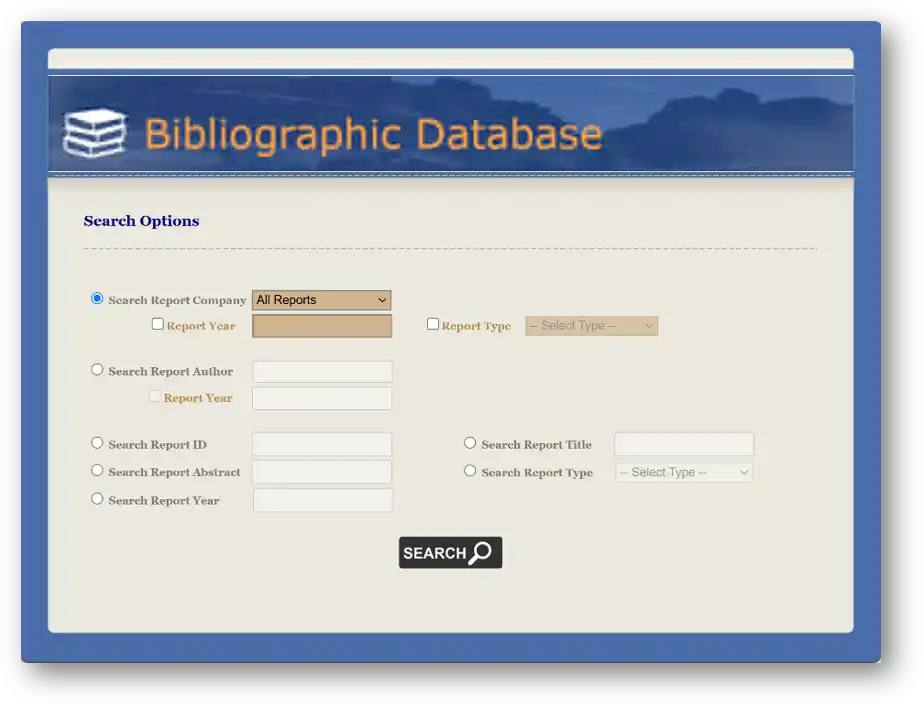
The Saudi NGD Bibliographic Database is a vital component of the National Geological Database (NGD) managed by the Saudi Geological Survey (SGS). It serves as a comprehensive digital repository of geological and mineral resource information related to Saudi Arabia. This database indexes an extensive range of materials, including:
- Books and maps.
- Technical and open-file reports.
- Scientific articles and other publications produced by the SGS.
The Bibliographic Database contains over 115,000 pages spread across 4,000+ reports. Although smaller in size compared to other prominent mining jurisdictions such as WAMEX and QDEX in Australia or SIGÉOM in Canada, this dataset still represents a monumental challenge for manual analysis.
The Challenge of Unlocking Unstructured Geological Data

These reports hold decades of knowledge and expertise from past geological explorers. However, much of this information remains locked within unstructured data sources, making it difficult to access and fully utilize.
Attempts to analyze this data using computational techniques like keyword searches or modern AI methods such as:
- Vector search.
- Contextual search.
- Retrieval-Augmented Generation (RAG).
While promising, these methods have fallen short of replicating the nuanced, context-driven analysis geologists perform. A geologist’s workflow combines careful reading, domain expertise, and pattern recognition to uncover new mineral deposits—a process not yet fully automated by traditional or modern computational methods.
How RadiXplore Bridges the Gap
RadiXplore’s Geoscience AI search platform is designed to replicate and enhance a geologist’s workflow. Let’s explore this through a graphite case study, showcasing how RadiXplore utilizes unstructured geological data to uncover valuable insights.
Graphite in Saudi Arabia: A Resource Worth Exploring
Graphite, a versatile mineral with diverse industrial applications, is found in various geological formations. Using the Saudi Minerals Inventory and Potential Assessment Report as a foundation, let’s explore the different types of graphite deposits and the potential for graphite mining in Saudi Arabia.
Understanding Graphite Geological Models
Natural graphite is classified into three primary types, each formed through distinct metamorphic processes:
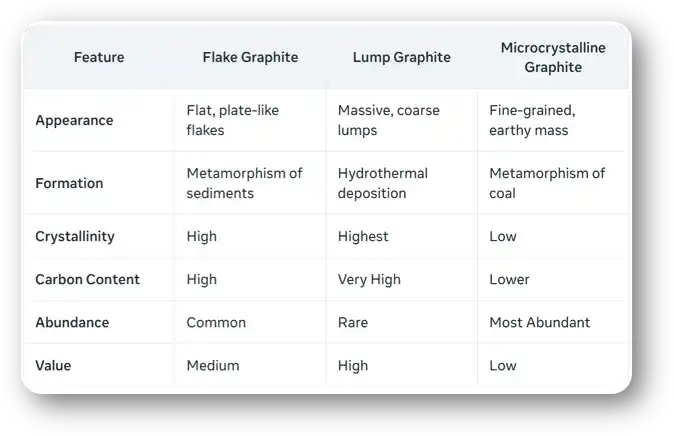
Disseminated Flake Graphite:
Key Characteristics: Economically viable concentrations are typically found at marble-paragneiss contact zones and within folded rock hinges.
Applications: Used in batteries, lubricants, and refractory materials due to its high purity and flake size.
Vein Graphite:
Key Characteristics: Occurs as lenses, pods, dikes, or veins, commonly found in similar rocks as flake graphite.
Applications: Preferred in high-tech applications like nuclear reactors and fuel cells due to its high crystallinity and purity.
Microcrystalline (Amorphous) Graphite:
Key Characteristics: A dull, earthy material that may retain traces of its original organic structure.
Applications: Primarily used in low-value industrial products like pencils, brake linings, and steel manufacturing.
Saudi Arabia’s Graphite Landscape
Globally, graphite deposits vary significantly in type and quality. In Saudi Arabia, the Saudi Minerals Inventory and Potential Assessment Report highlights that the country’s known graphite resources are predominantly of the disseminated flake variety. These occurrences are often associated with sulfide mineralization in geological terranes such as:
- Tathlith
- Nuqrah
- Ad Dawadimi
- Afif
- At Ta’if
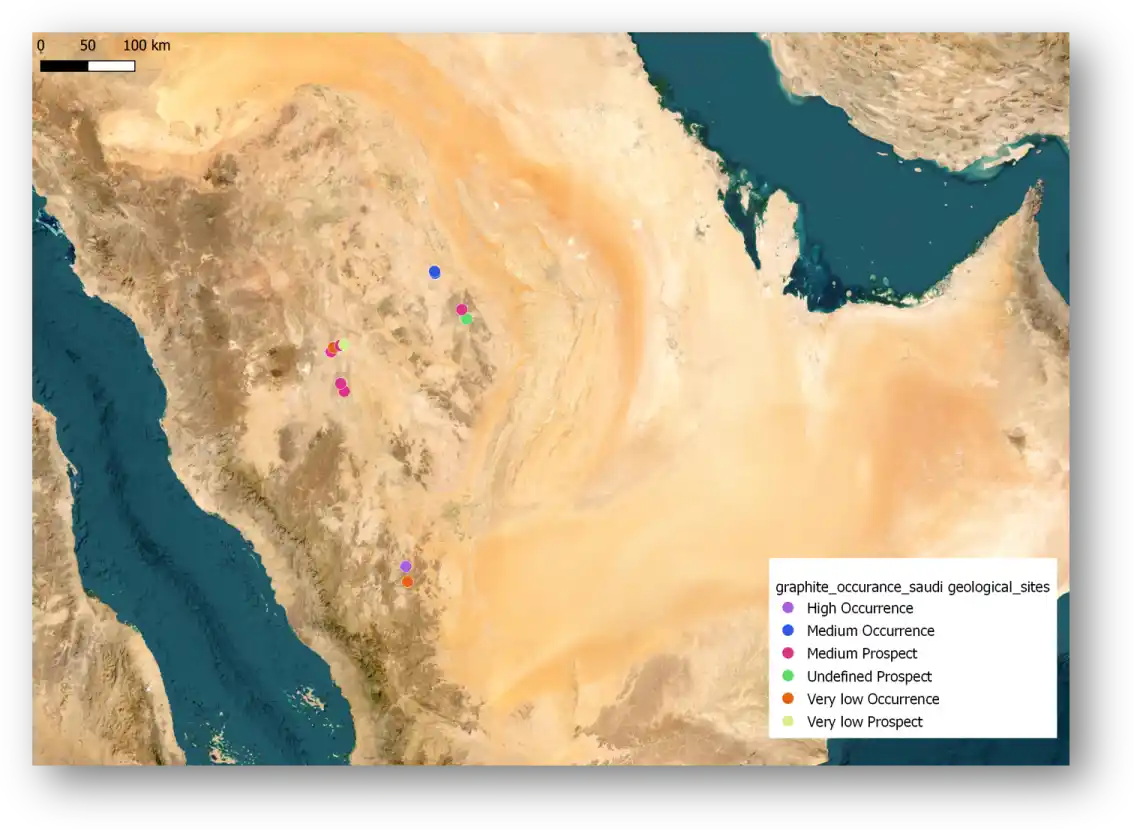
Wadi Rikhaman: A Promising Prospect
One of Saudi Arabia's most promising graphite deposits is located in Wadi Rikhaman. Key highlights include:
- Significant Unclassified Resources: Preliminary findings suggest considerable potential for extraction.
- Product Characteristics: The deposit is likely to yield a fine-grained graphite product with a graphitic carbon content of around 80%. This relatively low purity may limit its use to lower-value industrial applications, such as refractories or foundry facings.
- Future Development Needs: Realizing the full potential of Wadi Rikhaman requires extensive beneficiation testing to determine commercial viability and explore methods to enhance product quality.
AI to Identify Unrecognized Graphite Projects
Can RadiXplore AI Search Platform identify potential graphite projects overlooked in the Saudi Minerals Inventory and Potential Assessment Report by leveraging AI to analyze the NGD Bibliographic Database, just like a geologist would?
How Would a Geologist Manually Analyze the Bibliographic Reports?
The Challenges of Manual Analysis
While manually analyzing a few documents is feasible, scaling this process to handle hundreds of thousands of reports introduces significant challenges:
- Accurate Identification: Extracting precise details, such as assay data and geological contexts, from unstructured text.
- Geospatial Mapping: Translating extracted data into actionable maps across large datasets efficiently.
How RadiXplore Solves This
RadiXplore overcomes these challenges by leveraging cutting-edge AI to:
- Mimic Geologists' Expertise: Through deep learning, natural language processing, and advanced language models, RadiXplore replicates the nuanced way geologists analyze and interpret geological data, ensuring accurate and context-aware results.
- Enable Instant Mapping: By geotagging each document to its specific area, RadiXplore delivers instant geospatial mapping of search results, making data visualization and interpretation seamless
RadiXplore simplifies the process of searching for keywords like graphite while incorporating advanced AI techniques to enhance the results.
Analyzing Text in Reports
Let’s start with a seemingly simple task: searching for the keyword graphite.
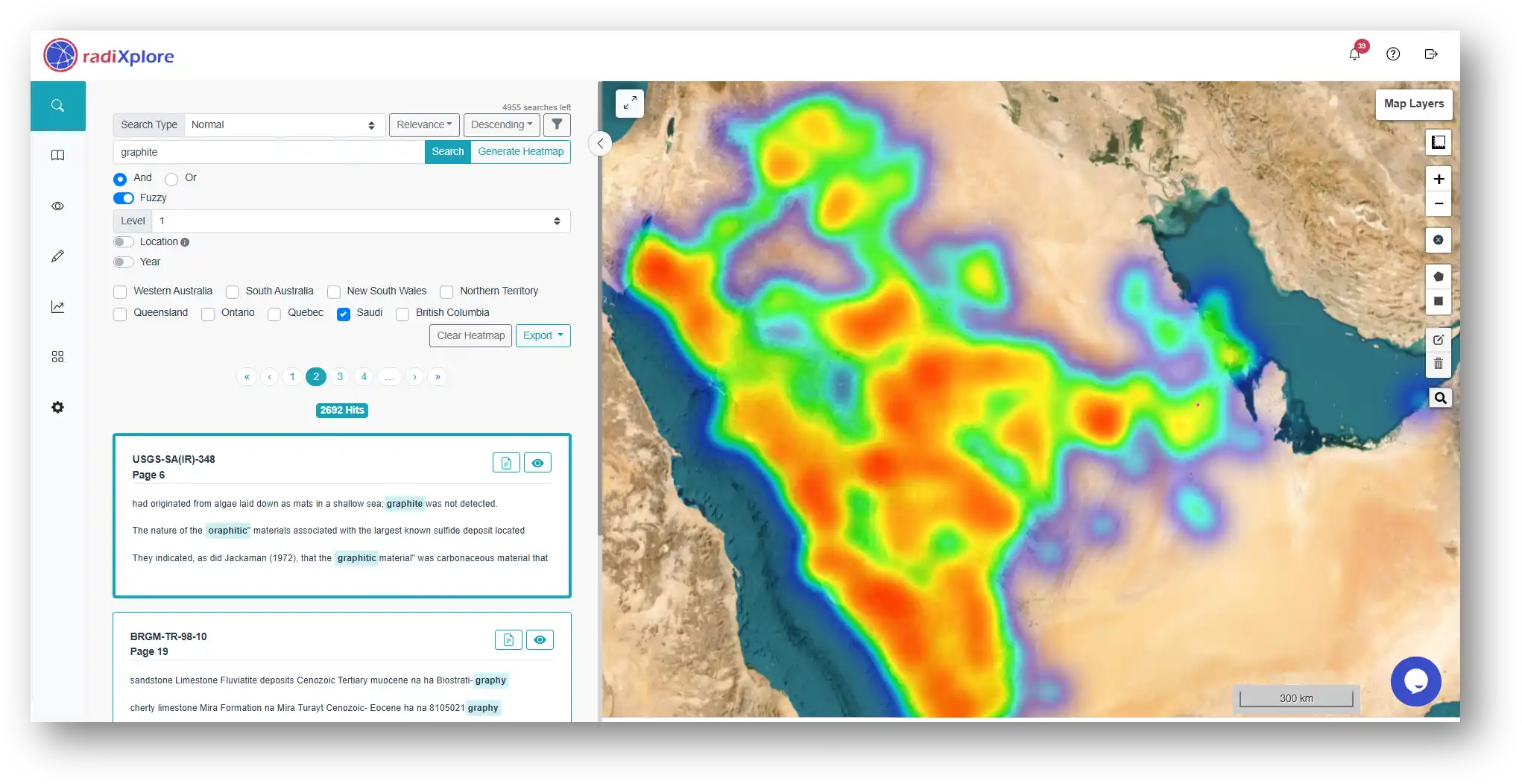
RadiXplore’s AI-powered search identified 2,692 instances of the keyword across over 100,000 documents from the NGD and created a geospatial visualization of these occurrences within seconds.
While this may sound straightforward, RadiXplore uses sophisticated AI methods to replicate human-level analysis. Whether the reports are scanned images, contain handwritten text, or include older, non-digital formats, all are fully searchable. Additionally, the platform intelligently handles variations of the keyword, such as graphitic, and spelling errors like oraphitic (see image), ensuring no relevant data is overlooked.
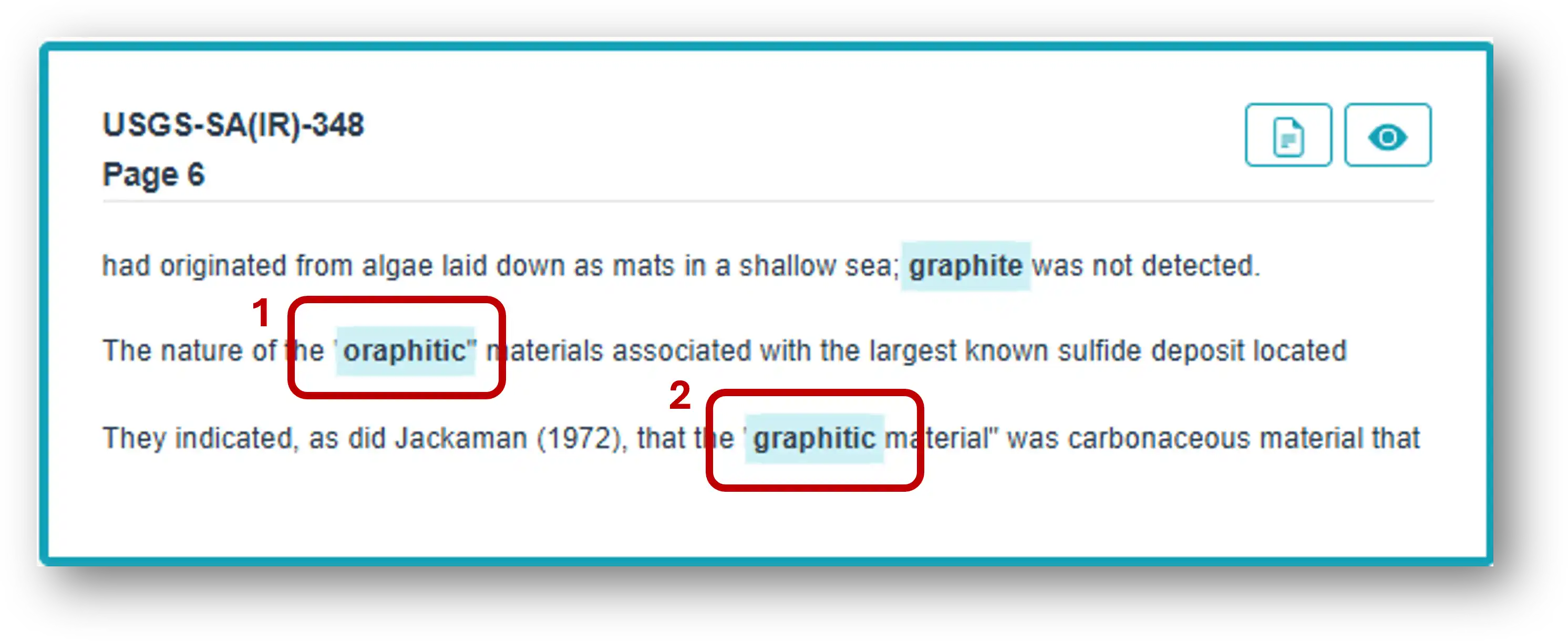
Exploring the Results
RadiXplore allows you to:
- View Document Metadata: Access the geo-tagged location of each document, as shown in the example below.

- Open Source PDFs: Directly navigate to the keyword's occurrence in the original document to assess the context of the result.
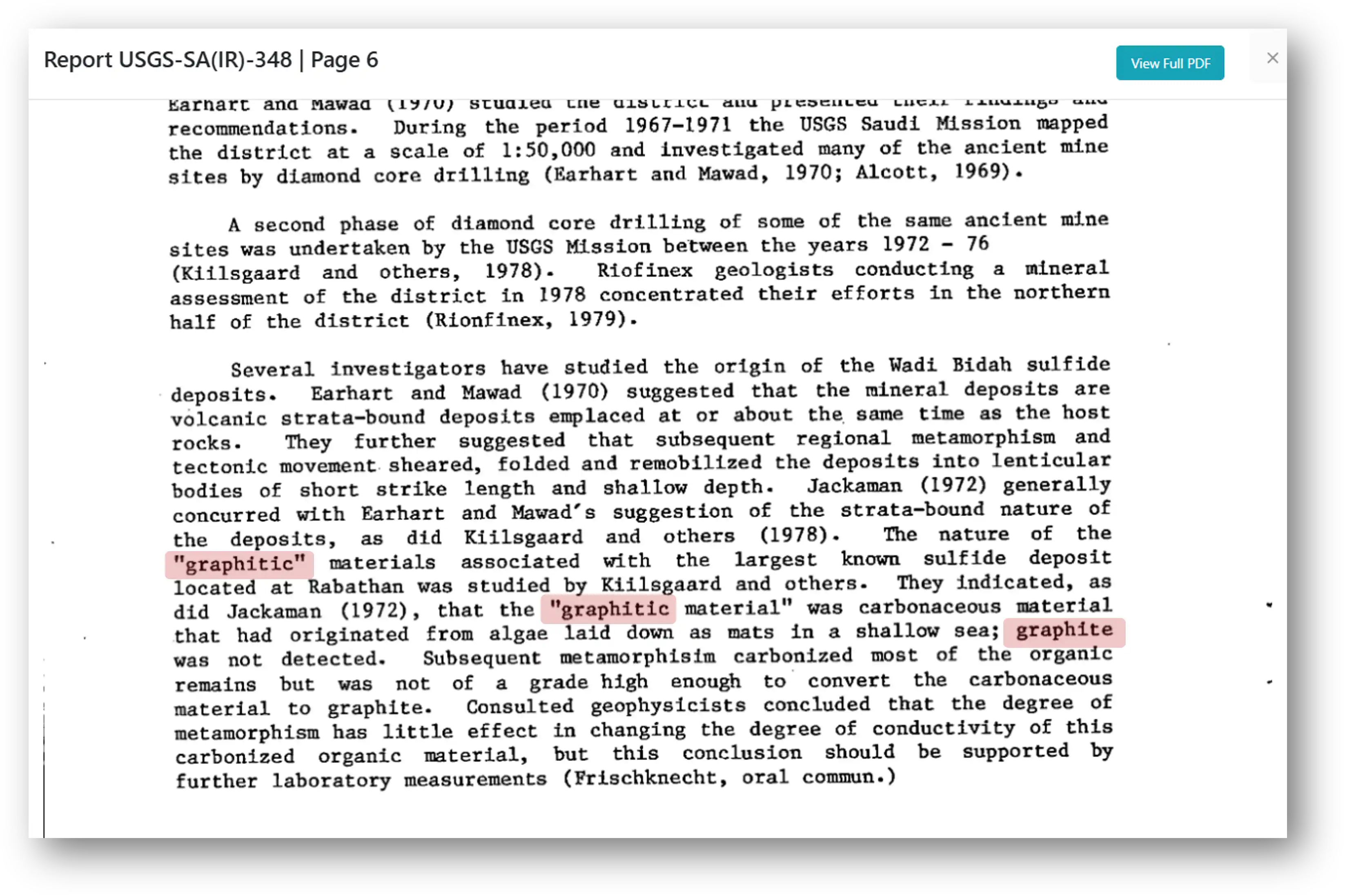
A Geologists Analysis of the Text from the Above Results
This report highlights a critical insight: while "graphitic" material was identified, it was determined to be carbonaceous, algal-derived matter rather than true graphite, due to insufficient metamorphic grade. However, this report also notes:
- The presence of extensive metasedimentary rocks.
- The large regional extent of the district.
- Uncertainty regarding the conductivity of the carbonaceous material.
- Limited previous investigations focused on a single deposit.
These factors suggest the potential for further exploration, despite the initial low likelihood of finding major graphite deposits.
Limitations of Keyword Searches
While keyword searches are powerful, they often yield a large number of false positives. This limitation is evident in the above example. Later in this blog post, we’ll explore how RadiXplore’s NerdSearch can refine searches by focusing on specific geological models, eliminating false positives, and delivering more actionable insights.
Analyzing Figures and Tables in Reports
Previously, we searched for graphite across all parts of a report—text, figures, and tables. However, some geologists prefer a more targeted approach. For instance, a geologist may want to identify pages containing figures such as maps or geological sections mentioning graphite and visually inspect these images for anomalies.
Manually browsing through 100,000 reports is a Herculean task. This is where RadixEye comes into play, leveraging a geoscience-specific AI vision model to streamline the process.
How RadixEye Simplifies Visual Searches
- Categorizing Figures
RadixEye identifies and categorizes figures within a report, such as geological maps, sections, or graphs, making it easier to pinpoint relevant visuals for exploration. - Keyword-Filtered Image Searches
Users can select a figure category and apply a keyword filter, such as graphite. RadiXplore’s advanced keyword search then narrows down the results to images containing references to the keyword.
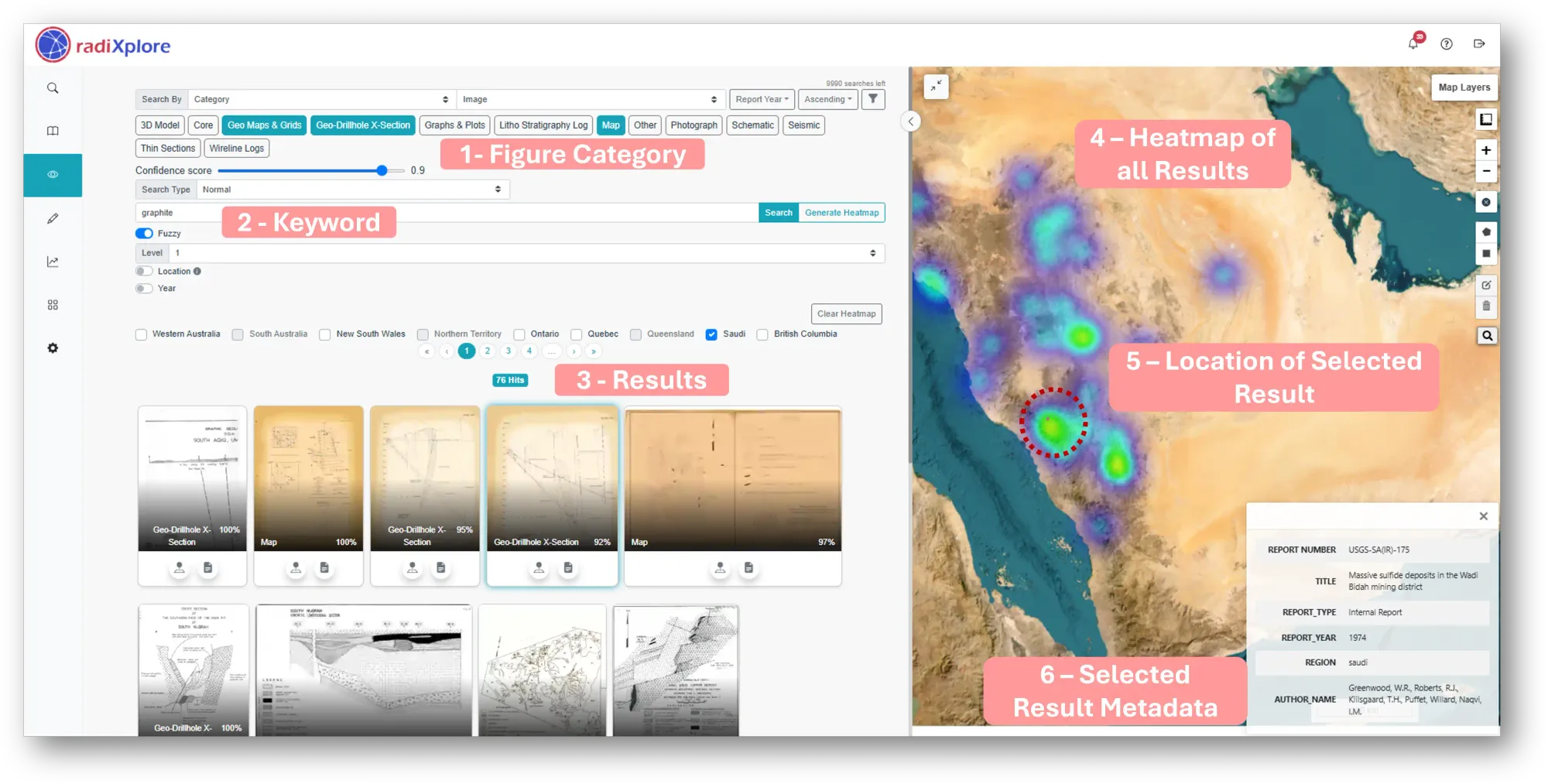
After locating relevant images, users can directly view them in RadixEye. For example, the platform identified a detected graphite schist zone. From this point, the user can:
- Use the "Search Similar" function to find other visually similar images within the database.
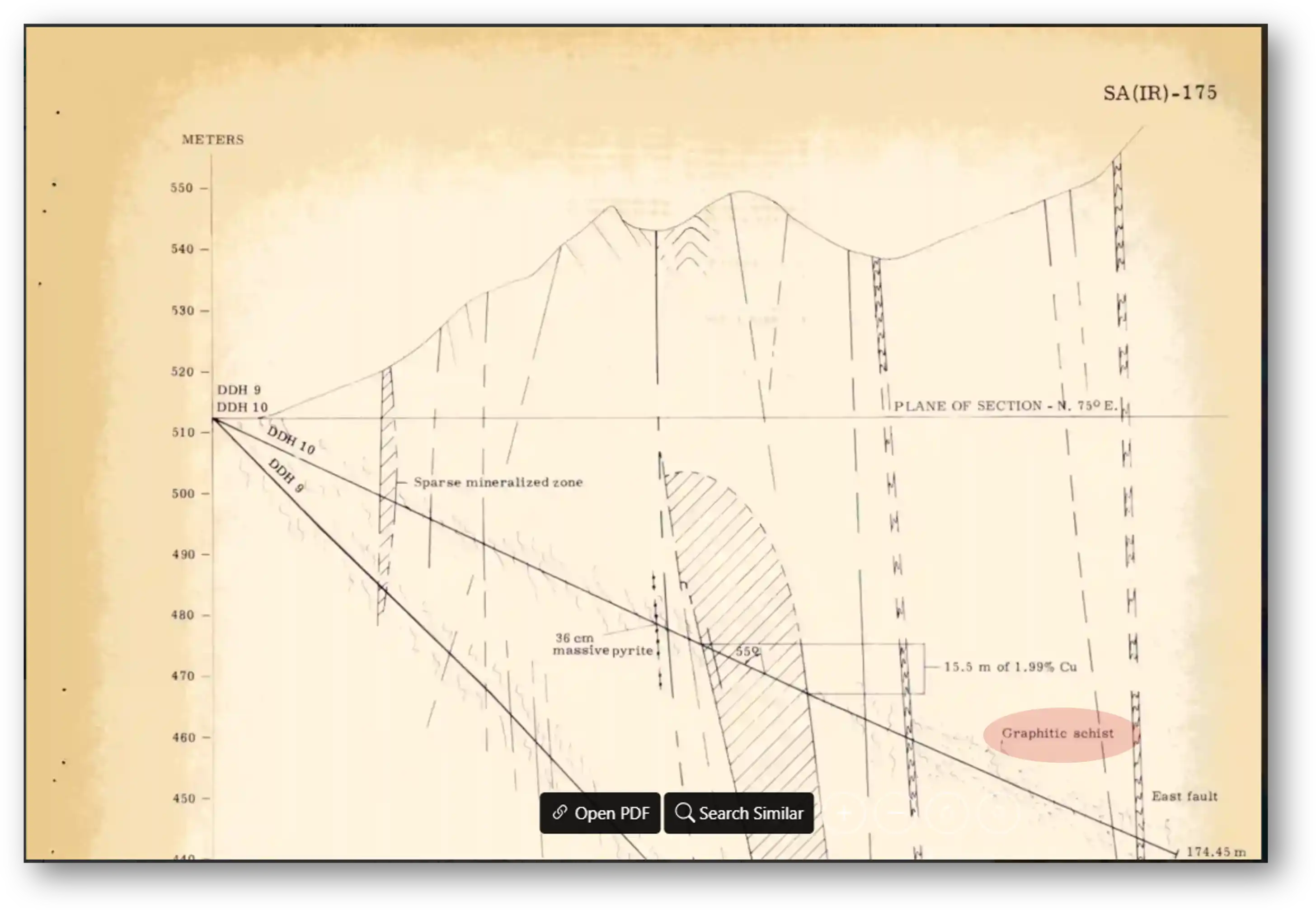
- Open the source PDF for additional context.
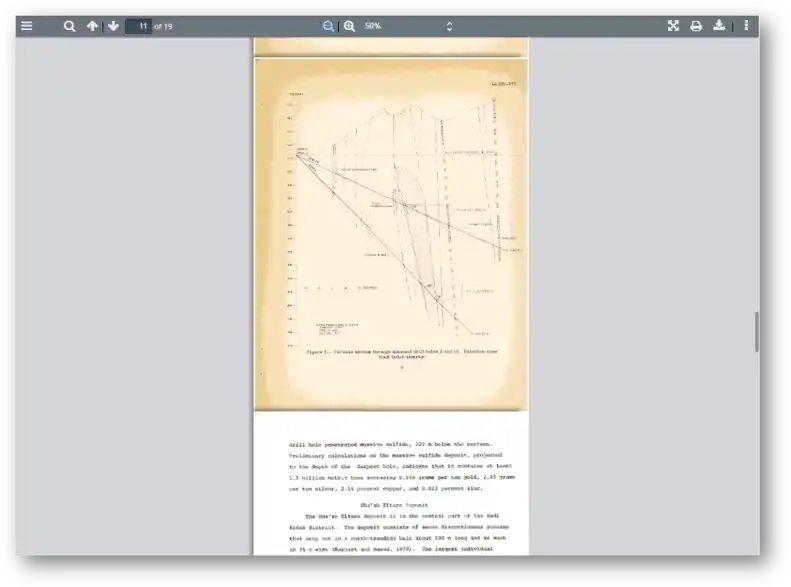
Browsing Tables Instead of Figures
RadixEye also simplifies table searches. Users can filter and browse tables containing relevant data, and then open the source PDF for deeper context.
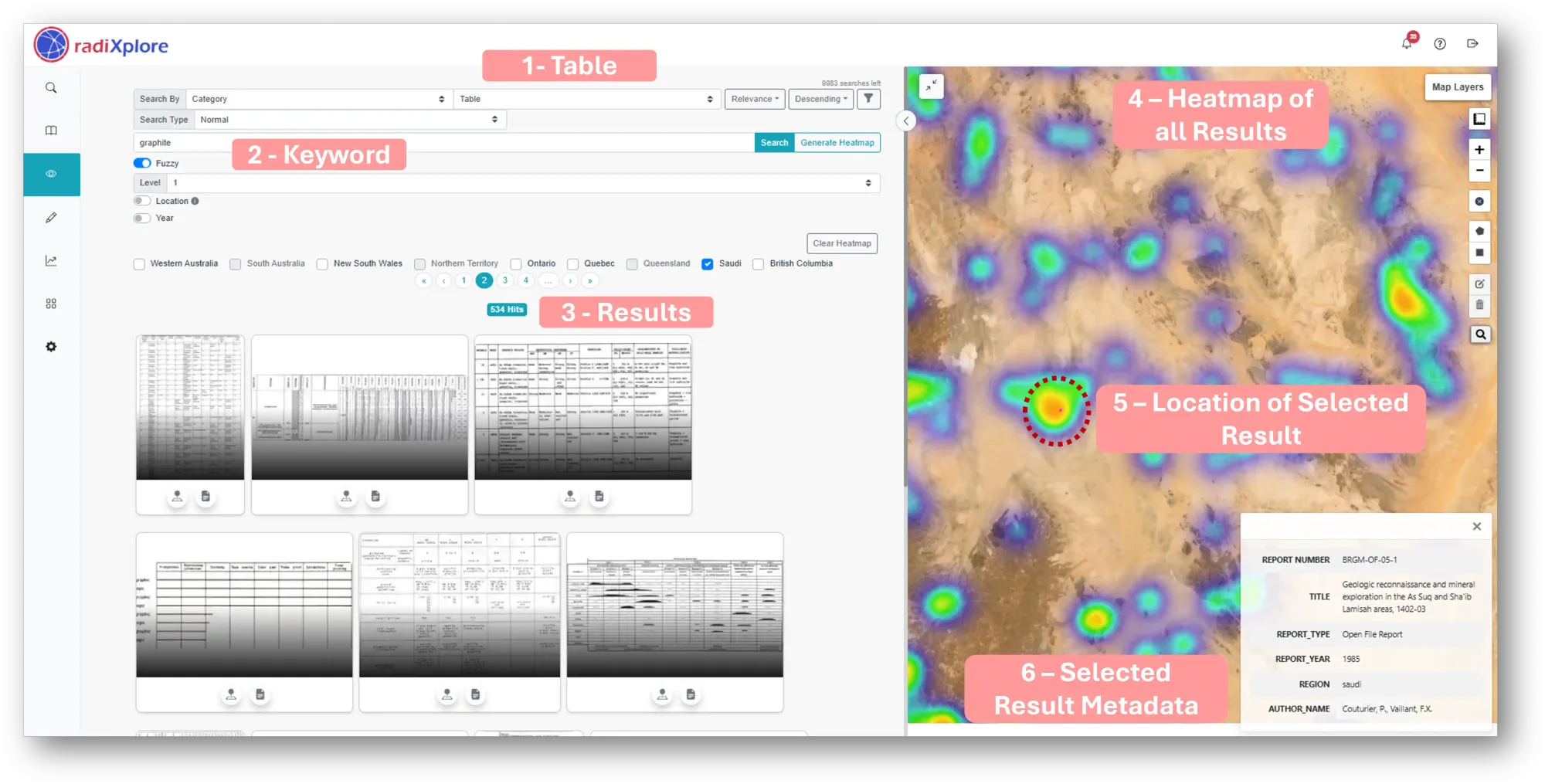

The Value of RadixEye for Visual Searches
By providing a streamlined way to analyze figures and tables, RadixEye adds another layer of depth to RadiXplore’s keyword search functionality. This capability is particularly useful when the goal is to visually assess anomalies or identify patterns that might not be immediately evident from text alone.
While keyword searches offer significant value, they sometimes fall short for more nuanced analyses. In the upcoming sections, we’ll explore moderate and complex examples to demonstrate how RadiXplore tackles these challenges effectively.
The NGD bibliographic database not only contains rich textual and image data but also holds valuable quantitative measurements hidden within sentences, figures, and tables. While keyword searches can help identify certain terms, extracting ranges of numbers requires more advanced techniques.
In structured databases like Excel or SQL, a simple range query can easily filter assay grades—for example, filtering for gold assays between 2 to 15 g/t. However, this becomes much more complex when assay data is embedded within sentences in unstructured reports, such as in text or maps.
Unfortunately, the majority of assay data in the NGD reports is buried in these unstructured formats. Companies often spend countless hours digitizing this data into structured databases but have only scratched the surface.
At RadiXplore, we leverage Natural Language Processing (NLP) to simulate range queries on unstructured datasets, unlocking valuable insights from reports that were previously inaccessible.
Example: Searching for Gold Assays Between 2 to 15 g/t
In the figure below, we conducted an assay search for gold grades between 2 to 15 g/t within the NGD reports. The results—13 instances—were mapped geospatially, just as in the previous example. The heat map provides a visual distribution of the findings, with metadata for each selected result.

Document Example
The document identifying these assay results is shown here.
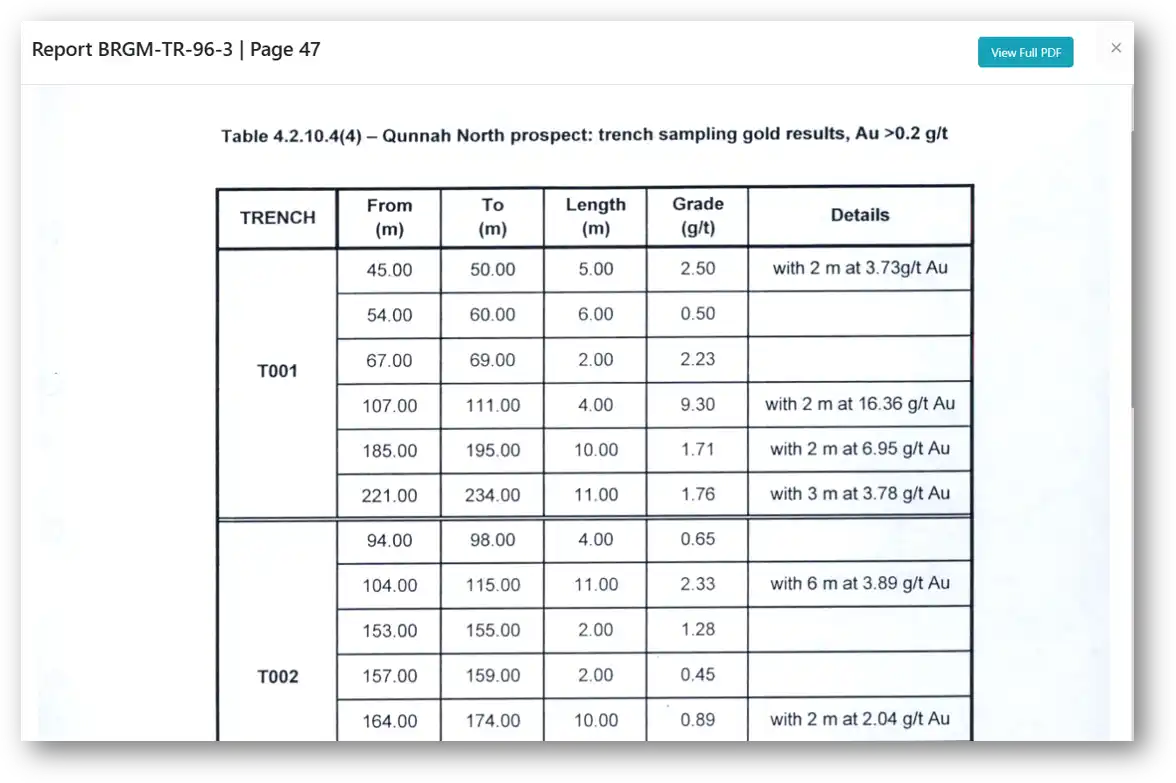
Assay Finder in RadixEye
This assay search functionality can be used within RadixEye, especially when you want to identify assays within specific categories, such as figures or tables.
Why Not a Graphite Example?
You may wonder why we didn’t use a graphite example for this technique. The key challenge is that the element carbon (C), which is central to graphite, is also common in many other contexts in the English language. As a result, searching for the term "C" leads to a large number of false positives, complicating the search. Moreover, the NGD bibliographic database contains few, if any, measured assays specifically for carbon, which is why graphite assays are not well-suited for this method.
The Insights from Assay Searches
While searching for assays might seem straightforward, it reveals an important insight: the mineralization discovered is often already known to the wider community. If your goal is to find the next big unrecognized deposit, this kind of assay search might not yield the most promising results. Mineral deposits with assays already reported are likely to be well-documented and widely recognized.
In the next section, we will explore how to find the unrecognized deposits—those that may have been missed and do not have measured assays reported.
As we discussed earlier, simple keyword searches often lead to a high number of false positives. But rather than searching for keywords, could we describe a mineral deposit using its text signature and map that geospatially?
What is a Text Signature?
A text signature represents a unique description of a deposit. It could be a geological model or even a proprietary approach based on the expertise of a company's geologists. The goal is to capture the specific characteristics and features that define a particular type of deposit, going beyond simple keywords.
For Saudi Arabia, the Saudi Minerals Inventory and Potential Assessment Report has already identified flake graphite deposits using the MODS database. Let’s explore if we can use the flake graphite geological model as a text signature to identify potential occurrences not already documented in the MODS database.
Geological Model for Flake Graphite
Here’s a quick overview of the key geological characteristics of flake graphite:
- Metamorphic Origin: Graphite forms through the metamorphism of carbon-rich sediments, typically in high-grade metamorphic terrains.
- Host Rock Associations: Schists, gneisses, and marbles provide a favorable environment for flake graphite mineralization.
- Textural Characteristics: Disseminated, platy, and foliated textures indicate the recrystallization of graphite during metamorphism.
- Accessory Mineral Assemblages: Minerals such as mica, quartz, and feldspar are often found alongside graphite due to shared metamorphic conditions.
How RadiXplore Identifies Flake Graphite Deposits Using NerdSearch
In RadiXplore, we use NerdSearch to capture this geological model and build a query that represents the signature of a flake graphite deposit. By doing so, we can expand the search beyond simple keyword searches and find occurrences that match this geological model.
Describing the Textural and Morphological Features of Flake Graphite
Let’s start by identifying the textural and morphological features of flake graphite that past geologists would have used:
- Disseminated: Refers to the scattered distribution of graphite flakes within the host rock.
- Platy and Foliated: Describes the typical flat, sheet-like, or layered structure of graphite, often formed under metamorphic conditions.
- Flake: Specifically targets flake graphite, a commercially valuable form of graphite.
Host Rocks
Now, let’s examine the common host rocks where flake graphite is typically found:
- Schist, Gneiss, and Marble: High-grade metamorphic rocks that often host flake graphite.
- Metasedimentary: Sedimentary rocks that have undergone metamorphism, typically enriched in organic carbon, the precursor to graphite.
- Metamorphic: A broader term referring to the geological processes responsible for graphite formation under heat and pressure.
Graphite Terminology Used by Past Explorers
The terminology used by past geologists to describe graphite deposits includes:
- Graphite, Carbon, Cg: These terms are commonly used to refer to graphite, its carbon content, or the shorthand for graphite content (Cg).
Associated Minerals
Next, let’s look at the associated minerals typically found in flake graphite deposits:
- Quartz and Feldspar: Major components of metamorphic rocks.
- Mica, Biotite, and Muscovite: Layered silicates often associated with graphite in metamorphic environments.
- Sulphides (e.g., Pyrite, denoted by pyr): Indicate potential co-mineralization or involvement of metamorphic fluids.
Exclusions: Hydrothermal and Vein Systems
We can exclude certain geological processes and deposit types that are unrelated to flake graphite:
- Hydrothermal, Epithermal, Vein: These processes are typically associated with fluid-driven mineralization, such as gold or base metals, and not with flake graphite. We exclude references to vein-type graphite deposits, which differ in formation and morphology from disseminated flake graphite.
Creating the Final Text Signature for Flake Graphite Deposits
Using the above terms, we can create a text signature for identifying flake graphite deposits. Here is our final signature:
Searching this signature using NerdSearch yielded 183 potential hits. While the MODS database suggests only a few known flake graphite deposits (indicated by the turquoise dot), RadiXplore generated a mineral potential map revealing several additional potential deposits across the shield.
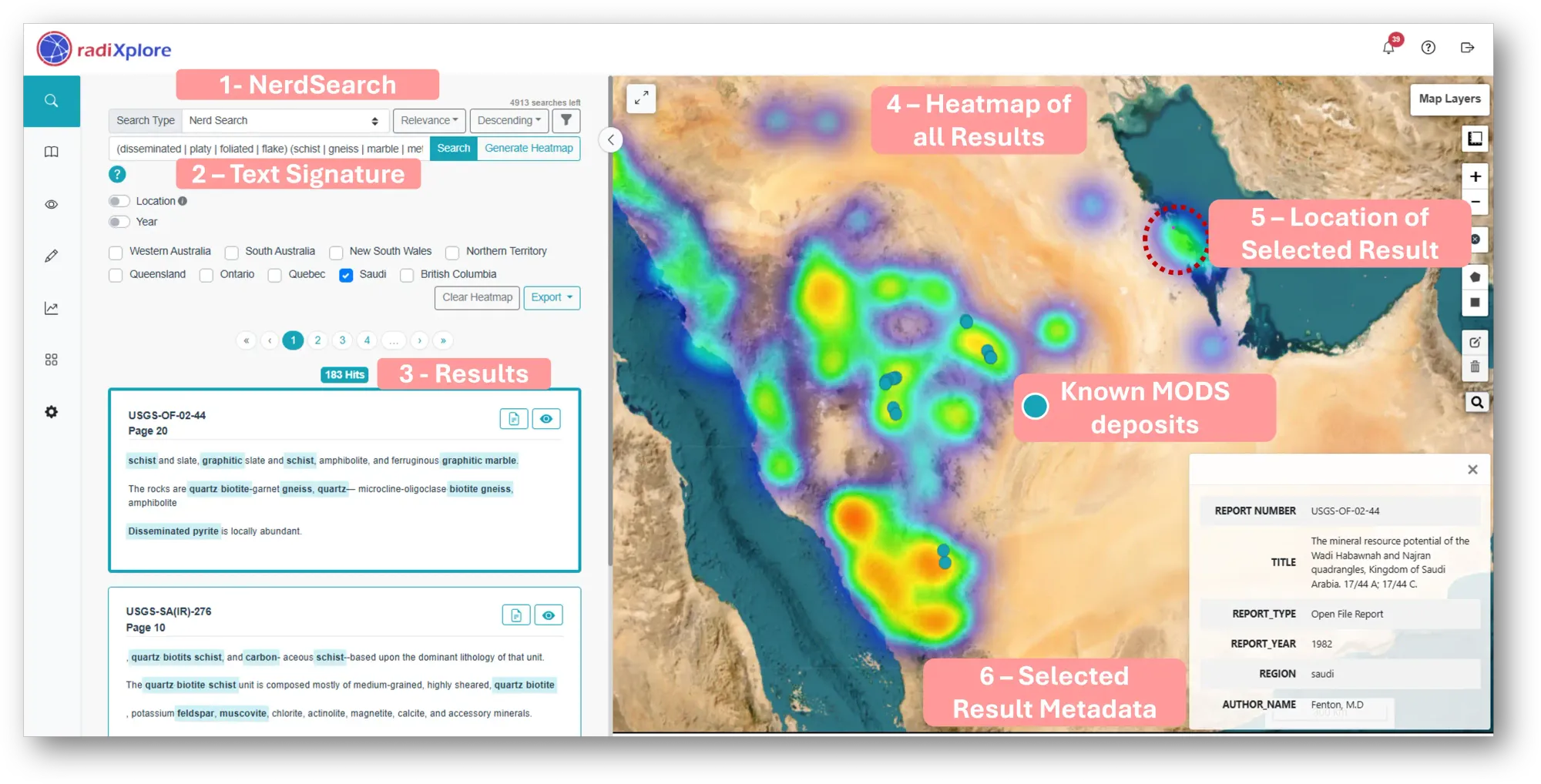
Analyzing the First Result: Could This Be a Potential Flake Graphite Deposit?
Now, let's put on the geologist's hat and analyze the text in the first result to assess whether it could indicate a potential flake graphite deposit. Below is the PDF page corresponding to the first result, which is USGS-OF-02-44 | Page 20.
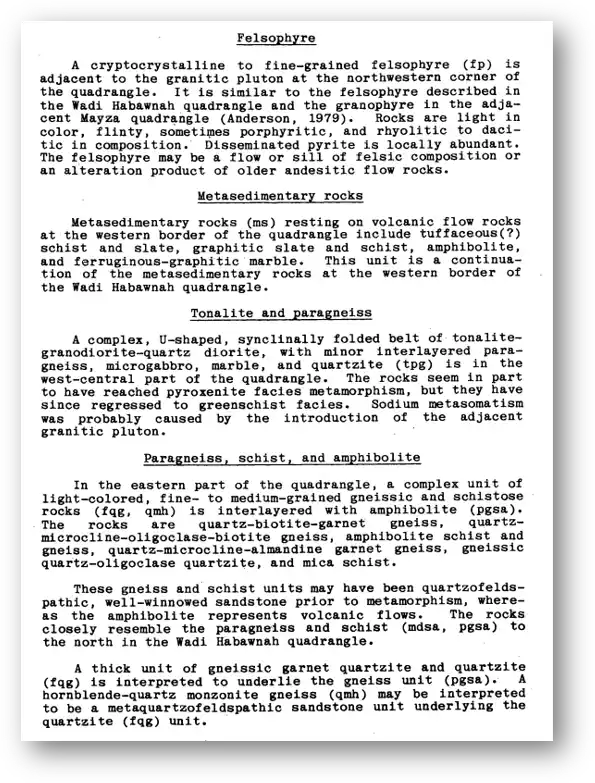
From the text, the description of the Metasedimentary rocks unit strongly suggests the potential for a flake graphite deposit. Here’s why:
- "Graphitic slate and schist": This is a key indicator. The presence of graphitic slate and schist directly implies graphite within these metamorphic rocks. Slate and schist are common host rocks for flake graphite, typically formed from the metamorphism of carbonaceous sedimentary rocks, such as black shales.
- "Ferruginous-graphitic marble": The mention of graphitic marble further reinforces the possibility. Marble forms from the metamorphism of limestone or dolostone. If these original carbonate rocks contain organic material, metamorphism can produce graphitic marble. The inclusion of "ferruginous" suggests the presence of iron oxides or hydroxides, which are sometimes associated with graphite deposits.
The other units described are less likely to host flake graphite:
- Felsophyre: This is a volcanic or shallow intrusive rock of felsic (high silica) composition. Although disseminated pyrite is mentioned, there is no indication of graphite.
- Tonalite and paragneiss: The description of these rocks focuses on the tonalite-granodiorite-quartz diorite suite, and the effects of metamorphism and metasomatism. No mention of graphite is made.
- Paragneiss, schist, and amphibolite (eastern part): While these rocks can host graphite, the description here does not specifically mention graphite. The focus is on the mineralogy (quartz, biotite, garnet) and inferred protoliths (quartzofeldspathic sandstone, volcanic flows).
The description of the Metasedimentary rocks unit, specifically the mention of "graphitic slate and schist" and "ferruginous-graphitic marble," strongly suggests the presence of flake graphite. This is the unit to investigate further when exploring for flake graphite deposits in this region. The other units, based on the provided descriptions, are unlikely to be prospective.
Deep Dive into the 9th Result: Report DGMR-Bulletin 25 | Page 12
This text presents a more complex scenario regarding the potential for flake graphite deposits. While there are indications of graphite, the context suggests it may not be the typical metamorphic flake graphite associated with large, economic deposits. Let's break down the key points:
- "Dark-gray thin-bedded graphitic schist" (Wadi Shakhlalah): This is the most direct evidence of graphite. Schist is a common host rock for flake graphite. However, the description is brief, and the context is crucial for interpretation.
- "The basal parts of at least two of the ash-flow tuffs and the subjacent sedimentary rocks are dark gray as a result of the introduction of very finely divided graphite": This is a significant point. The graphite described here appears to have been introduced into the ash-flow tuffs and adjacent sediments before metamorphism. This suggests a different origin from typical flake graphite, which forms during metamorphism of pre-existing organic-rich sediments. The text further explains that the graphite's irregular distribution is controlled by defect structures in phenocrysts and possibly by glass shards in the original rock. This implies a volcanic or hydrothermal origin, possibly through fumarolic activity or volcanic gas emissions during or shortly after the ash-flow eruptions.
- "Weakly graphitic and (or) pyritiferous locally" (quartzofeldspathic metatuff and associated metasedimentary rocks): This indicates the presence of graphite, but only weakly and locally. It suggests a lower concentration and less consistent distribution of graphite compared to a typical flake graphite deposit.
Geological Interpretation:
The graphite in the Wadi Shakhlalah area appears to have a more complex origin than typical metamorphic graphite deposits. Evidence suggests that it may have been introduced syn-volcanically or early post-volcanically, likely associated with volcanic activity tied to the ash-flow eruptions. This is distinct from the formation of typical flake graphite deposits, which result from the regional metamorphism of carbonaceous sedimentary rocks.
Implications for Flake Graphite Exploration:
While graphite is present, the geological context indicates that large, economically viable flake graphite deposits are less likely in this area. The graphite appears to be:
- Of a different origin: The graphite does not primarily form from the metamorphism of organic-rich sediments, but rather through volcanic or hydrothermal processes.
- Irregularly distributed: The graphite's distribution is controlled by volcanic features, not by consistent stratigraphic layers.
- Present in relatively low concentrations in some areas: Descriptions mention "weakly graphitic" sections, suggesting that the graphite is not present in the high concentrations typically found in flake graphite deposits.
While the text does describe the presence of graphite, including graphitic schist, the evidence points toward a volcanic or syn-volcanic introduction of graphite, rather than a metamorphic origin for the flake graphite. As a result, while graphite is present, this area is likely less prospective for large, economic flake graphite deposits compared to regions where graphite is associated with regional metamorphism of organic-rich sedimentary rocks.
Conclusion
In this exercise, we leveraged the power of AI combined with geological expertise to analyze over a hundred thousand pages of text, uncovering potential unrecognized graphite deposits in just a few hours. Historically, bibliographic datasets like NGD's—along with other unstructured reports from organizations and governments—have gone underutilized due to their labor-intensive nature. However, RadiXplore has revolutionized the process by enabling explorers, project generators, and geologists to focus on brainstorming new geological models and concepts while leaving the laborious task of searching through vast amounts of unstructured data to us.
With RadiXplore, you can unlock insights from these overlooked datasets and streamline your exploration process like never before.
Get started today
Contact us for a personalized demo or sign up for the free version of RadiXplore to experience the power of AI-driven exploration firsthand.

